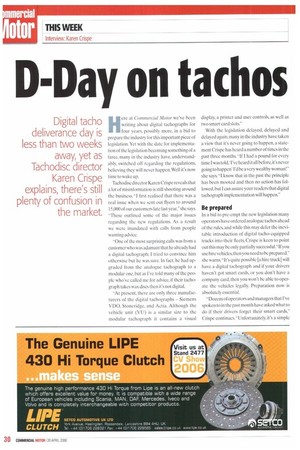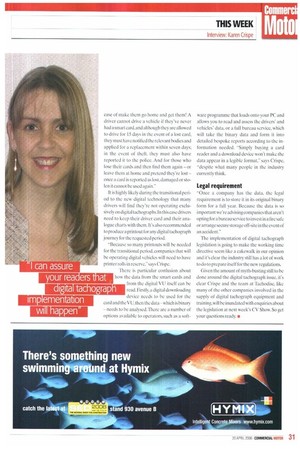D-Day on tachos
Page 30

Page 31

If you've noticed an error in this article please click here to report it so we can fix it.
Here at Commercial Motor we've been writing about digital tachographs for four years, possibly more, in a bid to prepare the industry for this important piece of legislation. Yet with the date for implementation of the legislation becoming something of a farce, many in the industry have, understandably, switched off regarding the regulations, believing they will never happen. Well it's now time to wake up.
Tachodisc director Karen Crispe reveals that a lot of misinformation is still shooting around the business. "I first realised that there was a real issue when we sent out flyers to around 15,000 of our customers late last year," she says. "These outlined some of the major issues regarding the new regulations. As a result we were inundated with calls from people wanting advice.
-One of the most surprising calls was from a customer who was adamant that he already had a digital tachograph; I tried to convince him otherwise but he was sure. In fact, he had upgraded from the analogue tachograph to a modular one, but as I've told many of the people who've called me for advice, if their tachograph takes wax discs then it's not digital.
"At present, there are only three manufacturers of the digital tachographs Siemens VDO, Stoneridge, and Actia. Although the vehicle unit (VU) is a similar size to the modular tachograph it contains a visual display, a printer and user controls, as well as two smart card slots."
With the legislation delayed, delayed and delayed again,many in the industry have taken a view that it's never going to happen, a statement Crispe has heard a number of times in the past three months. "If I had a pound for every time I was told,`I've heard it all before, it's never going to happen' I'd be a very wealthy woman!" she says."! know that in the past the principle has been mooted and then no action has followed,but I can assure your readers that digital tachograph implementation will happen."
Be prepared In a bid to pre-empt the new legislation many operators have ordered analogue tachos ahead of the rules, and while this may defer the inevitable introduction of digital tacho-equipped trucks into their fleets. Crispe is keen to point out this maybe only partially successful."If you use hire vehicles, then you need to be prepared." she warns. "It's quite possible [a hire truck] will have a digital tachograph and if your drivers haven't got smart cards, or you don't have a company card, then you won't be able to operate the vehicles legally. Preparation now is absolutely essential.
"Dozens of operators and managers that I've spoken to in the past month have asked what to do if their drivers forget their smart cards," Crispe continues. -Unfortunately, it's a simple case of make them go home and get them! A driver cannot drive a vehicle if they've never had a smart card,and although they are allowed to drive for 15 days in the event of a lost card, they must have notified the relevant bodies and applied for a replacement within seven days; in the event of theft, they must also have reported it to the police. And for those who lose their cards and then find them again — or leave them at home and pretend they're lost — once a card is reported as lost, damaged or stolen it cannot be used again."
It is highly likely during the transitional period to the new digital technology that many drivers will find they're not operating exclusively on digital tachographs. In this case drivers need to keep their driver card and their analogue charts with them. It's also recommended to produce a printout for any digital tachograph journey for the requested period.
"Because so many printouts will he needed for the transitional period, companies that will be operating digital vehicles will need to have printer rolls in reserve," says Crispe.
There is particular confusion about how the data from the smart cards and from the digital VU itself can be read. Firstly a digital downloading device needs to be used for the card and the VU. then the data which is binary — needs to be analysed. There are a number of options available to operators, such as a soft ware programme that loads onto your PC and allows you to read and assess the drivers' and vehicles' data, or a full bureau service, which will take the binary data and form it into detailed bespoke reports according to the information needed. "Simply buying a card reader and a download device won't make the data appear in a legible format," says Crispe, "despite what many people in the industry currently think.
Legal requirement "Once a company has the data, the legal requirement is to store it in its original binary form for a full year. Because the data is so important we're advising companies that aren't opting for a bureau service to invest in a fire safe or arrange secure storage off-site in the event of an accident."
The implementation of digital tachograph legislation is going to make the working time directive seem like a cakewalk in our opinion and it's clear the industry still has a lot of work to do to prepare itself for the new regulations.
Given the amount of myth-busting still lobe done around the digital tachograph issue, it's clear Crispe and the team at Tachodisc, like many of the other companies involved in the supply of digital tachograph equipment and training, will be inundated with enquiries about the legislation at next week's CV Show. So get your questions ready. •




















































































































































































































